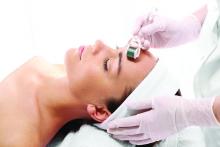, but only a few actually have any scientific data or clinical studies supporting their claims. In general, these rollers promise to increase collagen, depuff the skin, lift and firm, increase circulation, increase oxygenation, and decrease inflammation. But no clinically significant results have been reported with most of these over-the-counter devices. Furthermore, not every roller is meant for every skin type – and some should stay within the hands of an experienced professional.
Crystal rollers consist mainly of jade and quartz rollers. In Chinese medicine, jade is known as the “stone of Heaven.” It has been thought to relax the nerves and aid in removal of toxins. Jade stones are generally nonporous and thus, do not harbor bacteria. These crystal rollers are rolled across the skin to calm swelling and redness. Their cooling properties along with proper rolling mechanisms can help drain lymphatics, leaving the eye area slightly less puffy.Ice rollers have been used for many years and are very effective to cool the skin for in-office procedures. They are drum-shaped stainless steel rollers that are left in the freezer and cool the epidermis upon application. At-home ice rollers cause immediate vasoconstriction and are a quick fix for periorbital edema or skin erythema. Three-dimensional roller face massagers are simply a massage tool and can be used on any skin type to increase facial circulation; they do not provide any visible clinical benefits. Nanocurrent or vibrating rollers use nanocurrents and vibration alongside a conductor gel to glide across the skin; they massage the skin and help topically applied agents penetrate into the stratum corneum.
Microneedling rollers, which are the most complex, are widely used as facial rollers in homes and in dermatology offices. Microneedling or collagen induction therapy is a technique whereby 0.5- to 3.5-mm needles pierce the stratum corneum and create a wound healing cascade, stimulating growth factor release and neocollagenesis. The standard “dermaroller” is a drum-shaped roller with 192 fine microneedles in eight rows, 0.5-1.5 mm in length and 0.1-0.25 mm in diameter. When used properly, this technique is a wonderful treatment for fine lines and acne scars.Dermatologists and plastic surgeons use automated microneedling devices with disposable needles at 1.0-2.5 mm depth for acne scars, burn scars, hyperpigmentation, striae, fine lines, and wrinkles. The home care dermarollers, however, have a needle length of 0.15-0.5 mm and are used for only reduction of pore size and delivery of topically applied skin preparations. These devices should be only single use and used with extreme caution. The skin must be sterilized as pinpoint needle injury to the skin can cause bleeding and skin infection. Although widely marketed to consumers, any needle-based device should be used by only licensed and trained professionals.Dr. Talakoub and Dr. Wesley are cocontributors to this column. Dr. Talakoub is in private practice in McLean, Va. Dr. Wesley practices dermatology in Beverly Hills, Calif. This month’s column is by Dr. Talakoub. Write to them at dermnews@mdedge.com. They had no relevant disclosures.
References
Orentreich DS et al. Dermatol Surg. 1995;21(6):543-9.
Aust MC et al. Plast Reconstr Surg. 2008;21(4):1421-9.Fernandes D et al. Clin Dermatol. 2008 Mar-Apr;26(2):192-9.




